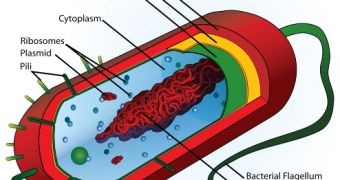Apparently bacteria cells have the natural ability to determine when the conditions around them become too dangerous for their existence and to adapt accordingly. While this has been a widely known fact about them, scientists weren't able to understand the exact nature of the complicated process involved in changing the way bacteria react to outside stimuli until recently.
In a discovery published in the Science journal on the 3rd of October, Marin van Heel, professor at the Department of Life Sciences at Imperial College of London, and colleagues were able to identify the bacterial "command center," named "stressosome." Up to twenty such formations exist in every bacterial cell, analyzing impulses received from receptors placed in the cellular membrane.
When warning signals hit one or more of the stressosomes, they react and catalyze the process of transcription in certain genes, creating more proteins of specific kinds. These proteins enforce the cellular membrane against the very stimuli that threaten it and thus allow the whole cell to survive even in the roughest conditions. As proof, bacteria have been found in even the most remote places, living under tons of rock, near molten lava and in the deepest layers of some glaciers. Needles to say, most of these places could never support human life. Because they are so versatile and simple in their make, bacteria find it relatively easy to adapt their unicellular bodies to most outside factors.
Scientists behind the study now hope to use state-of-the-art microscopic imaging at their disposal to identify the relevant amino-acids in the stressosomes that develop the response to outside conditions. They also hope to better understand what exactly happens when the cell mutates and more importantly, how it does it so fast. The speed of the morphological changes is amazing and it constitutes one of the key factors of bacterial survival.
Van Heel and his team also want to study how the response can be so effective and the mechanisms by which the command centers identify the exact nature of the threat and develop a response in short periods of time.

 14 DAY TRIAL //
14 DAY TRIAL //